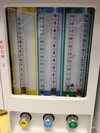Anesthesia Equipment -Italian + Lab (LS) Flashcards
What is this?

Pressure regulator
What is this?

flow meter
What is this?

Vaporizer
What is this for?

O2 Flush valve
What is this?

Hanger yoke
(where the tanks hook up)
What is this?

Pressure regulator
(comes in from 02 tank & goes to flow meter)
What happens at the Flow Meter?
Brings the pressure down to 14.7 PSI (from 50 PSI)
What happens at the Pressure regulator?
Brings the pressure from 2000 PSI → 50 PSI
What is your PSI at the O2 Flush Valve?
What implications does this have?
- 50 PSI
- Do NOT use if hooked up to patient → barotrauma!!!
Why do we need a vaporizer?
allows drug to go from liquid to gas form
Where to you refill the vaporizer?
At the filler port

What is the dial used for?

To control the plane of anesthesia
Where can you check the agent level of the vaporizer?
the sight glass

What is this?

Common gas outlet
What happens at the Common Gas Outlet?
Pressure at this point?
- exit point for mixture of carrier gas + inhalant anesthetic + flow
- 14 PSI
What is the purpose of the Pin Index System?

To ensure the proper medical gas cyclinder is used
Know Your TANK COLORS!!

What is the color code for CO2?
GREY
(both)
What is the color code for He/O2?
USA→ Brown/Green
ISO→ Brown/White
What is the color code for Medical Air?
USA → Yellow
ISO→ Black & White
What is the color code for Nitrogen (N2)?
BLACK
(both)
What is the color code for Nitrous Oxide (N2O)?
BLUE
(both)
What is the color code for Oxygen (O2)?
USA → Green
ISO → White
What is the color code for Suction (Vaccum)?
USA → White
ISO → Yellow





